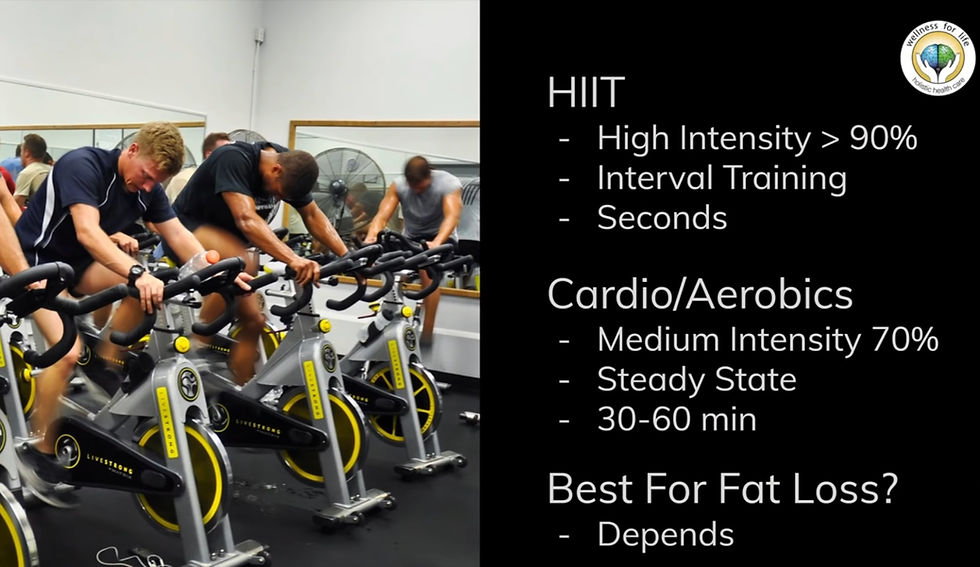13. Lose Fat Fast - Which is Better? HIIT vs. Cardio
- Michelle W
- May 17, 2023
- 4 min read
Updated: Jun 9, 2023
Dr. Sten Ekberg is a holistic doctor and a former Olympic decathlete. He has published another video comparing HIIT and cardio exercise for fat loss efficiency. Let's take a look at it together.
At the beginning, he reminded us why we exercise. We exercise for brain activation, hormone balance, improved circulation, anti-aging benefit, better balance of the body, better quality of life, and fat burning, of course. But are all the exercise created equal? Not really.
HIIT is high intensity interval training, which gets your heart rate up above 90% of your maximum. If you are not really fit, you don't want to start from HIIT. You need to work your way up to that. Interval training means we have short burst of intense activity mixed with periods of rest and recovery. When the intensity is that high, w can only keep it up for seconds.
People often mean the same thing when they talk about cardio or aerobic. This is when we have a medium intensity exercise and the heart rate is somewhere around 70% or a little bit more. Often times we talk about cardio as a steady state without longer period of complete recovery like we do in HIIT. Because it is medium intensity, we can keep it longer, around 30 to 60min.

Which one is better for fat loss? It depends. Given a guy of 40-year-old as an example, his maximum heart rate is calculated as 220 minus his age, which is 180 bpm. In the figure below, it shows when his heart rate from resting (60 bpm) to maximum (180 bpm), the activity type gradually transits from "Aerobic" to "Anaerobic". Aerobic means exercise with air. When the exercise is getting intense, oxygen is not enough, then it switches to anaerobic range. (This part is mentioned also in a previous post comparing walking and running. ) Dr. Ekberg emphasized here that it is ironic that people sometimes call cardio exercise "aerobics", while in really it is "anaerobic". Aerobic exercise includes walking, slow biking and roller blading at a moderate pace without huffing and puffing. When you push yourself to walk faster, bike faster, now you turn them into anaerobic exercise. HIIT is located near the maximum heart rate range. It includes sprints, climbing stairs and burpees.

Our body can use two types of fuel, fat and glucose. During aerobic exercise, we burn more fat than glucose when oxygen is abundant. When doing cardio, oxygen is not enough to support burning a lot more fat, the body starts to rely more on glucose. When moving from cardio to HIIT, glucose burning becomes even more dominant.

However, when we consider which exercise is better for fat burning, we should also look at what the impact exercise makes on our hormones, and what the impact hormones make on fat burning or fat storing. The two hormones in question are human growth hormone (HGH) and cortisol. HGH is considered good and cortisol is considered bad under this context. (More details can be find in a previous post comparing walking and running). When we do aerobic training, HGH goes up. As the training intensity goes up, HGH increases more. During HIIT training, the HGH can increase a lot more, which can be as much as 700% even for a short interval. Then for cortisol, during aerobic training, since the body mainly burns fat with enough oxygen, there is little need to increase blood sugar level, so the cortisol almost does not increase. As soon as we cross into that anaerobic range, the body needs to add more glucose as fuel. So cortisol level increases to let the body make more blood sugar. For HIIT, the body needs to make even more blood sugar, because we are burning through that glucose even faster.

But the key is that the HIIT is such short bursts of activity, we might only keep it up for two to three minutes. Even if the workout itself lasts 5 or 10 or 15 minutes, the intense bursts only add up to about 2 to 3 minutes. When we multiply it by time, the total impact of cortisol is very small for HIIT. On the other hand, for cardio training, the impact of cortisol is multiplied by 30 to 40min or more, depending on how long you sustain that activity. During that time, our adrenals have to work really hard.

Now you can see if we want to optimize HGH and minimize cortisol, both HIIT and the aerobic training do that, but the anaerobic sustained activity doesn't do that. So whether we do this for health benefits or fat burning, the outcome isn't the same.
However, which exercise to choose is also depending on the fitness condition of each individual. Dr. Ekberg gave two examples. In scenario 1, if the 40-year old is a lean, fit and healthy individual whose fitness goal is to keep healthy, improve fitness level and gain six-pack. His training combination of a week can be 3 times of aerobic exercise of 60min each, plus 3 times of anaerobic (cardio) exercise of 30-60min each, plus 2 times of HIIT of 5min each.

In scenario 2, if the 40-year old has belly fat, and has been eating junk food for 20 years. His fitness goal is to lose weight, lose fat and be healthy. His training combination of a week can be 3 to 5 times of aerobic exercise of 60 to 90min each, plus 1 times of anaerobic (cardio) exercise of 20min, plus 2 times of HIIT of 5min only.

Following these examples, I am sure you can make up a fitness plan that best fit your own goals.



Comments